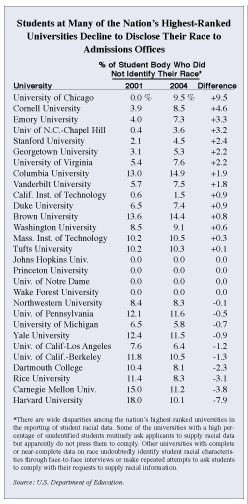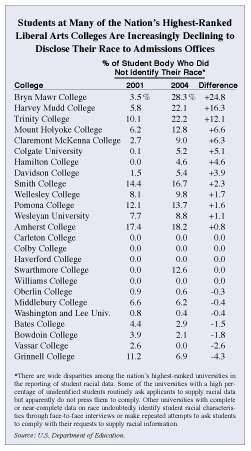| Applicants to Selective Colleges Show Increasing Reluctance to Disclose Their Race An increasing number of applicants to the highest-ranking colleges and universities are declining to disclose their race. Now some colleges are reporting that they do not know the race of 25 percent or more of their students. We note that if the nondisclosure trend continues, it will become more difficult to track the progress blacks are making in higher education.Also, the reluctance of student applicants to identify their race presents a problem for the college and university administrators who are required to submit data on the racial makeup of their student bodies to the Department of Education. As a result, some high-ranking colleges and universities are taking steps to secure more complete data on the racial makeup of their students. A century ago the nation's most prestigious institutions of higher education never bothered to ask student applicants to disclose their race. For the most part, college administrators could reasonably assume that anyone who would apply to a top school, and who possessed the academic qualifications for admission, was white. But in the early half of the twentieth century, some colleges asked prospective students to attach personal photographs to their applications. At the time colleges often used the photograph as a safeguard either to exclude Jewish students or to enforce Jewish quotas. The application photograph also served to ensure that no black students would slip through the admissions procedure. Beginning in the 1950s and 1960s when most colleges and universities began to accept and recruit black students, almost all college admissions offices asked students to note their race on the application form. Nearly all students willingly did so.
Beginning in the late 1970s, the newly formed Department of Education required colleges and universities that accepted federal aid to submit annual reports to the federal government on the racial makeup of their student bodies. Colleges that failed to comply were in danger of losing all federal funding including the availability of government loans for students attending those colleges. In order to collect the data for submission to the Department of Education, the colleges and universities used the racial information collected on student application forms. Habits are changing. In recent years many students have become reluctant to disclose their race on college applications. A new study by the James Irvine Foundation's Campus Diversity Initiative finds that in 2001, 5.9 percent of all college students declined to disclose their race on their application form. This is up from 3.2 percent in 1991. The foundation compared official racial enrollment statistics at three colleges in California with data on college freshmen collected by the Cooperative Institutional Research Program at UCLA. The foundation concluded that students who had already matriculated at college were far more willing to divulge their race to the researchers at UCLA than they were to the admissions office of the college to which they applied. The foundation was then able to compare the racial admissions data to the racial statistics on freshman students. This analysis led the foundation to conclude that the vast majority of those students who declined to divulge their race on the college application form are white. Racial Unknowns at High-Ranking
JBHE has compiled data on the nation's 30 highest-ranked universities from the Department of Education as to the percentage of students who have not divulged their race to their college's administration. According to the Department of Education's enrollment data, a far greater percentage of students at the highest-ranked schools do not supply racial data than is the case for all students nationwide who chose not to disclose their race. For example, in 2004, according to the official figures, Colum-bia University reported to the U.S. Department of Education that 14.9 percent of the student body had not been identified by race. At Brown University, 14.4 percent of the students are classified as "racial unknowns." In fact, at seven of the nation's 29 highest-ranked universities in 2004, at least 10 percent of the student body, according to JBHE's count, has not been racially identified. In contrast, at four of the 29 high-ranking universities — Johns Hopkins, Princeton, Notre Dame, and Wake Forest — the administration was able to classify all of their undergraduate students by race. At some of the nation's most selective liberal arts colleges the number of racial unknowns is even higher than at the high-ranking universities. At eight of the 25 highest-ranked liberal arts colleges, the percentage of students listed as "race unknown" is greater than 10 percent. At Bryn Mawr College, Harvey Mudd College, and Trinity College, more than one of every five students is listed as not having identified their race. On the other hand, five top liberal arts colleges — Vassar, Carleton, Williams, Colby, and Haverford — have identified the race of all their students. Students Are Increasingly Reluctant to Note Their Race on College Applications JBHE research also shows that the number of students who decline to divulge their race is on the rise. At 15 of the nation's 29 highest-ranked universities, the percentage of racial unknowns increased from 2001 to 2004. The largest increase was at the University of Chicago. In 2001 the university reported racial data for all of its undergraduate students. In 2004, 9.5 percent of the student body was listed in the race unknown category. Ten of the 29 leading universities showed a decline in the percentage of students in the racial unknown category. The largest decrease was at Harvard. In 2001 Harvard reported that 18 percent of its students had declined to divulge their race. By 2004 the percentage had dropped to 10.1 percent. At the leading liberal arts colleges the trend in racial unknowns is generally on the upswing. At 14 of the 25 leading liberal arts colleges there has been an increase in the percentage of students who have not disclosed their race. The largest increase was at Bryn Mawr College. In 2001 only 3.5 percent of the students did not disclose their race. Just three years later, the percentage had increased to 28.3 percent. Harvey Mudd, Trinity, and Swarthmore also had far more students who decided not to reveal their race in 2004 than had been the case three years earlier. At seven of the top 25 liberal arts colleges the percentage of students withholding racial data declined in the 2001-04 period. But in most cases the declines were negligible. Only at Vassar and Grinnell colleges were the declines more than two percentage points. Some Explanations for the Reluctance to Disclose Racial Information Why are students increasingly reluctant to disclose their racial identities to college admissions officials? Undoubtedly, some students believe their mixed racial background does not fit into the narrow categories usually listed on the application forms, such as white, black, Asian, Hispanic, or American Indian. On the other hand, many biracial students have no trouble with the historical "one drop" rule and designate themselves black even when they may have one parent or one grandparent who is an African American. A small number of conservative black students may leave the racial classification question blank in order that their application be judged solely on the basis of merit with no consideration of race. Charles J. Johnson, a sophomore at Harvard College who has one white and one black parent, decided to check "other" when asked for his race on the Harvard application form. He told the Harvard Crimson recently that "I didn't want to get in just because I'm African American. I did not want to be a victim of positive discrimination."
But most admissions officials believe that a vast majority of the students who do not choose to divulge their race are white students who feel a disclosure that they are white works to their disadvantage in the admissions process. These students are said to believe that whites are discriminated against in favor of blacks during the admissions process. Therefore, they decline to provide racial data in the belief that their whiteness will work against them. Another question that must be addressed is, Why are there such wide differences among the top schools in the percentage of students who fill in the racial data on application forms? How can Vassar and Princeton report racial statistics on their entire student body while Bryn Mawr does not know the race of more than a quarter of its students? There are several possible explanations: • Some colleges may emphasize on their applications that the submission of racial data is entirely optional. At other schools it may be less clear on the application form that the information is not required. Or, a particular college might explain on the application form why the information is important, and this statement could increase the percentage of students who are willing to respond. However, a JBHE survey of this year's application forms finds that this theory could explain only a tiny fraction of the huge differences in compliance with requests for information on an applicant's race. Almost all, if not all, of the top schools emphasize that the data is optional. Most colleges and universities phrase the request by saying something along the lines of: "If you wish to be identified with a particular ethnic group, please check all boxes that apply." Many of the colleges with a high percentage of students who do not identify themselves by race are among the hundreds of selective colleges and universities that use the Common Application Form. This form need be filled out only once and sent to all the colleges and universities to which the student applies. This form clearly states that supplying racial information is optional. In fact, the racial categories are placed in a separate box that is headed in boldface type, "The following items are optional. No information you provide will be used in a discriminatory manner." • It appears that many of the colleges and universities with the highest percentage of students who are listed as "race unknown" are among the most selective in the nation. These include Harvard, Amherst, Brown, Yale, Columbia, and the University of Pennsylvania. Prospective students may have the impression that these schools are more likely than others to pursue aggressive affirmative action policies in the admissions process that favor blacks. Therefore, white students who apply to these schools may believe that they face a serious disadvantage if they identify their race. • During the interview process, some college and university admission officials might note the race of some applicants who declined to divulge the information on their application form. They may then add this information to the student's permanent record. The schools may attempt to include racial information on all applicants so that they comply with Department of Education regulations. Other schools may respect students' wishes and not record the race of students who decline to divulge the information. These schools with a high rate of racial unknowns may not make further efforts to identify a student's race after the initial application is filed. • Some universities or colleges ask admitted students who declined to reveal their race on the application form to supply the data once they have been accepted or once they enroll. This could explain why some schools appear to have racial data on all of their students while other similar schools have a large percentage of students for whom no racial data exists. Once they are admitted, many white students who feared that their race would be used to their disadvantage in the admissions process might be more amenable to complying with the institution's request for racial information once they know they have been admitted. Indeed, this is the case at Haverford College outside of Philadelphia. Jess Lord, dean of admission and financial aid at Haverford, told JBHE that about 15 percent of all applicants decline to disclose their race on application forms. But Haverford requires all students to fill out its Student Entry Record (SER) before they matriculate. "Among many other questions, there is a question asking students to self-identify their race," Dean Lord reports. "All but two of this year's freshmen answered the question the first time through. Our registrar contacted these two students individually and they were willing to answer the question to him." As a result, on the forms Haverford submits to the Department of Education, there are no racial unknowns among its undergraduate students. It is likely that other colleges and universities with few or no students classified as racial unknowns also make follow-up efforts to identify the race of students who did not check off a racial classification on their application form. Those colleges and universities with large percentages of students who do not identify their race probably make little or no effort to supplement the racial data collected through the application process. Haverford's data supports the findings of the new study by the James Irvine Foundation's Campus Diversity Initiative on the racial makeup of the group which fails to divulge ethnic and racial information on application forms. Dean Lord notes that Haverford's follow-up Student Entry Record data shows that "nearly all of the students who do not self-identify their race on their admission applications are white." | |





